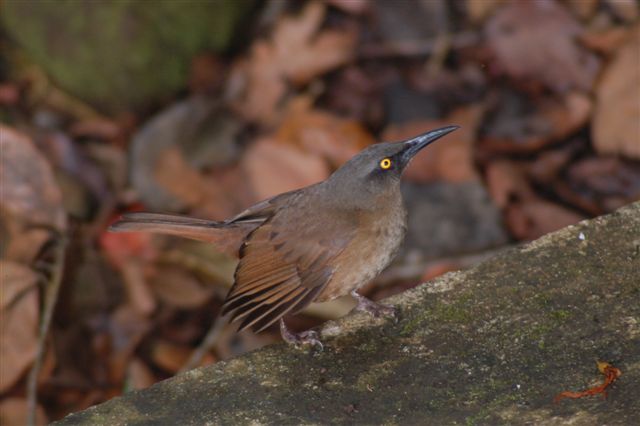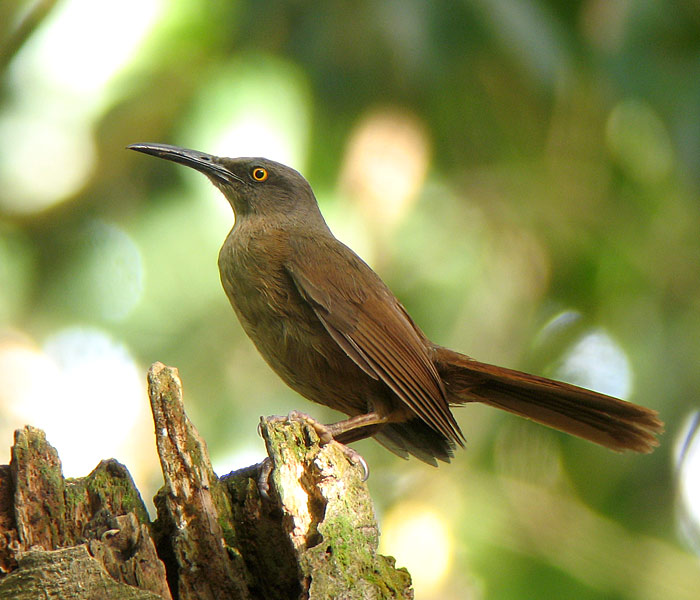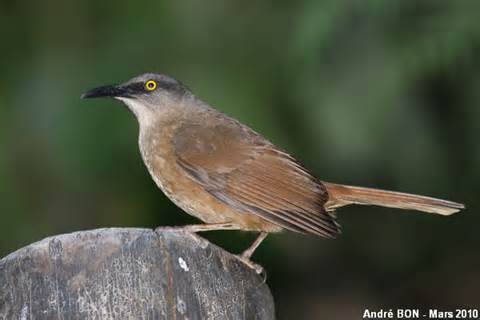
Cinclocerthia ruficauda
TAXONOMY
Stenorhynchus ruficauda Gould, 1835. Three subspecies.
OTHER COMMON NAMES
English: Brown bird, gray trembler, (Caribbean) trembling
thrush; French: Trembleur brun; German: Zitterdrossel; Spanish:
Temblador Castaсo.
PHYSICAL CHARACTERISTICS
9–10 in (23–25.5 m); 1.8 oz (50 g) (average). Upperparts dark
olivaceous-brown, with blackish brown crown and rufescent
rump. Underparts dull gray-brown, becoming orange-brown
on belly. Eyes light yellow. Bill long, slender and decurved,
black; legs brown. Females have longer bill than males; juveniles
faintly spotted on chest.
DISTRIBUTION
C. r. ruficauda Dominica, West Indies; C. r. tremula Saba south
to Guadeloupe, W.I.; C. r. tenebrosa, St. Vincent, W.I.
HABITAT
Wet forest with epiphytes, more rarely in grapefruit, cacao,
and banana plantations.
BEHAVIOR
Occurs at all levels from the ground to tree-crowns. Occurs in
pairs or small groups. Has peculiar habit of trembling, consisting
of drooping both wings then quickly bringing them upwards
while jerking the tail nervously. On ground it hops with
cocked tail. Song is varied; loud notes uttered at intervals,
some rich and warbled, others harsh or squeaky.
FEEDING ECOLOGY AND DIET
Food very varied; much invertebrate matter including insects,
spiders, scorpions, and snails, also small tree-frogs and
lizards. Fruit and berries including seedpods. Feeds at all levels;
probes into ground and epiphytes with long bill; clings to
tree trunks while probing into cavities in the manner of a
woodcreeper.
REPRODUCTIVE BIOLOGY
Nest is a cup of rootlets, lined with finer material, in the base
of a palm frond, in a tree cavity, or in a hollow stump; may use
nest-boxes. Some nests reported to be domed with a side entrance.
Eggs two to three, unmarked greenish blue. Incubation
and fledging periods not recorded.
CONSERVATION STATUS
Not threatened. On several islands, populations are much reduced
due to habitat destruction, but still abundant on Dominica
and common on Guadeloupe and Saba. Extinct on St. Eustatius.
SIGNIFICANCE TO HUMANS
None known.
Photo Gallery of - Brown trembler




 Animalia Life
Animalia Life